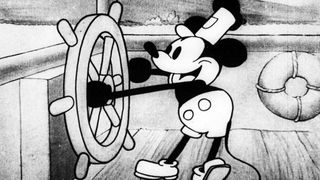The Book of Life on Disney Plus
Understand Disney's 12 principles of animation

Disney's 12 principles of animation were first introduced by animators Ollie Johnston and Frank Thomas in their book The Illusion of Life: Disney Animation, first released in 1981. Through examining the work of leading Disney animators from the 1930s onwards, this book sees Johnston and Thomas boil their approach down to 12 basic principles of animation.
Forming the basis of all animation work, these principles are relevant for a number of different fields. Though the clearest use is for animating a character (see our character design tips here), these rules are also an invaluable guide in other areas, for instance, when introducing motion into your interface with some CSS animation.
In this article, we take a closer look at each animation principle. To see them in action, you could consider signing up to Disney Plus (see below for a special Disney Plus Day deal) or try them out yourself with the best tablets for animation paired with the best animation software.
This article features GIFs from Vincenzo Lodigiani, who also made the short video The Illusion of Life (below).
Once you understand these 12 principles of animation, you'll be able to take your motion work to the next level. These are the principles and what they mean:
- Learn more about animation with a 3D World magazine subscription
01. Squash and stretch
The squash and stretch principle is considered the most important of the 12 principles of animation. When applied, it gives your animated characters and objects the illusion of gravity, weight, mass and flexibility. Think about how a bouncing rubber ball may react when tossed into the air: the ball stretches when it travels up and down and squishes when it hits the ground.
When using squash and stretch, it's important to keep the object's volume consistent. So when you stretch something it needs to get thinner, and when you squash something it needs to get wider.
- Mickey Mouse from above is still the most haunting thing online
02. Anticipation
Anticipation helps to prepare the viewer for what's about to happen. When applied, it has the effect of making the object's action more realistic.
Consider how if might look if you were to jump in the air without bending your knees, or perhaps to throw a ball without first pulling your arm back. It would appear very unnatural (it may not even be possible to jump without bending your knees!). In the same way, animating movements without a flicker of anticipation will also make your motion seem awkward, stale and lifeless.
03. Staging
Staging in animation is a lot like composition in artwork. What we mean by that is, you should use motion to guide the viewer's eye and draw attention to what's important within the scene. Keep the focus on what's important within the scene, and keep the motion of everything else of non-importance to a minimum.
04. Straight ahead action and pose to pose
There are two ways to handle drawing animation: straight ahead and pose to pose. Each has its own benefits, and the two approaches are often combined. Straight ahead action involves drawing frame-by-frame from start to finish. If you're looking for fluid, realistic movements, straight ahead action is your best bet.
With the pose to pose technique, you draw the beginning frame, the end frame, and a few key frames in-between. Then you go back and complete the rest. This technique gives you a bit more control within the scene and allows you to increase the dramatic effect of the motion.
05. Follow through and overlapping action
When objects come to a standstill after being in motion, different parts of the object will stop at different rates. Similarly, not everything on an object will move at the same rate. This forms the essence of the fifth of Disney's principles of animation.
If your character is running across the scene, their arms and legs may be moving at a different rate from their head. This is overlapping action. Likewise, when they stop running, their hair will likely continue to move for a few frames before coming to rest – this is follow through. These are important principles to understand if you want your animation to flow realistically.
06. Slow in and slow out
The best way to understand slow in and slow out is to think about how a car starts up and stops. It will start moving slowly, before gaining momentum and speeding up. The reverse will happen when the car brakes. In animation, this effect is achieved by adding more frames at the beginning and end of an action sequence. Apply this principle to give your objects more life.
07. Arc
When working in animation, it's best to stick with the laws of physics. Most objects follow an arc or a path when they're moving, and your animations should reflect that arc. For example, when you toss a ball into the air, it follows a natural arc as the effects of the Earth's gravity act upon it.
08. Secondary action
Secondary actions are used to support or emphasise the main action going on within a scene. Adding secondary actions help add more dimension to your characters and objects.
For instance, the subtle movement of your character's hair as they walk, or perhaps a facial expression or a secondary object reacting to the first. Whatever the case may be, this secondary action should not distract from the primary one.
09. Timing
For this principle of animation we need to look to the laws of physics again, and apply what we see in the natural world to our animations. In this case, the focus is on timing.
If you move an object more quickly or slowly than it would naturally move in the real world, the effect won't be believable. Using the correct timing allows you to control the mood and the reaction of your characters and objects. That's not to say you can't push things a little (especially if you're creating an imaginary world) – but if you do, be consistent.
10. Exaggeration
Too much realism can ruin an animation, making it appear static and boring. Instead, add some exaggeration to your characters and objects to make them more dynamic. Find ways to push the limits just beyond what's possible, and your animations will pop.
11. Solid drawing
You need to understand the basics of drawing. This includes knowing how to draw in three-dimensional space and understanding form and anatomy, weight and volume, and lights and shadows.
While you can push the limits here, too, it's important to remain consistent. If your world has wonky doors and a warped perspective, keep that perspective throughout the entire animation. Otherwise, things will fall apart.
12. Appeal
Your characters, objects, and the world in which they live need to appeal to the viewer. This includes having an easy-to-read design, solid drawing, and a personality. There is no formula for getting this right, but it starts with strong character development and being able to tell your story through the art of animation.
Related articles:
- The 12 Best YouTube art channels
- Disney Plus movies: The best films on Disney+ right now
- Must-see art shows on Disney Plus

Tammy is an independent creative professional. She enjoys working on projects from content creation – including books, tutorials, videos, and podcasts – to the design and development of cross-platform applications and games.
Related articles
The Book of Life on Disney Plus
Source: https://www.creativebloq.com/advice/understand-the-12-principles-of-animation
0 Response to "The Book of Life on Disney Plus"
Post a Comment